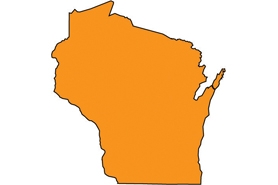Yellow flag iris
(Iris pseudacorus)
Yellow flag iris is a showy perennial plant that can grow in a range of conditions from drier upland sites to wetlands to floating aquatic mats. A native plant of Eurasia, it can be an invasive garden escapee in Wisconsin's natural environments.
Other names for this plant include:
- Common names: Yellow flag iris, water flag, European yellow iris, pale-yellow iris.
Classification in Wisconsin: Restricted
- Ecological Threat
-
- Yellow flag iris can produce many seeds that float from the parent plant, or plants can spread vegetatively via rhizome fragments. Once established, it forms dense clumps or floating mats that can alter wildlife habitat and species diversity.
- All parts of this plant are poisonous, which results in lowered wildlife food sources in areas where it dominates.
- This species can escape water gardens and ponds and grow in controlled and natural environments. It can grow in wetlands, forests, bogs, swamps, marshes, lakes, streams and ponds.
- Dense areas of this plant may alter hydrology by trapping sediment.
- Identification
-
Leaves & stems: Broad, sword-shaped leaves grow upright, tall and stiff. They are green with a slight blue-grey tint and are very difficult to distinguish from other ornamental or native iris species. Flowers are produced on a stem that can grow 3-4 feet tall among leaves that are usually as tall or taller.
Flowers: Showy and variable in color from almost white to a vibrant dark yellow. Flowers are 3-4 inches wide and bloom from April to June. Three upright petals are less showy than the larger three downward pointing sepals, which may have brown to purple colored streaks.
Fruits & seeds: Seeds are produced in fruits that are 6-angled capsules, 2-4 inches long. Each fruit may have over 100 seeds that start pale before turning dark brown. Each seed has a hard outer casing with a small air space underneath, which allows the seeds to float.
Roots: Thick, fleshy pink-colored rhizomes spread extensively in good conditions, forming thick mats that can float on the water's surface.
Similar species: When not flowering, the yellow flag iris could be easily confused with the native blue flag iris (Iris versicolor) as well as other ornamental irises that are not invasive. The blue flag iris is usually more miniature and does not tend to form as dense clumps or floating mats. When not flowering or showing fruiting bodies, the yellow flag iris may be confused with other wetland plants such as cattails (Typha spp.) or sweet flag (Acorus spp.) species.
- Distribution
-
See the reported locations of yellow flag iris in Wisconsin.
Do you know of other populations? Please send us a report.
- Control
- Mechanical:
- Small populations may be successfully removed using physical methods. Care should be taken if hand-pulling plants as some people show skin sensitivity to plant sap and tissues. All parts of the plant should be dug out – particularly rhizomes and disposed of in a landfill or by burning.
- Cutting the seed heads may help decrease the plant spreading.
- Aquatic formulas of herbicides may be used to control yellow flag iris. However, permits may be needed. Foliar spray, cut stem/leaf, application, and hand swiping of herbicide have all shown effectiveness.
- Resources
- Sources for content:
- Invasive Species Specialist Groups: Global Invasive Species Database: Information page [exit DNR]
- USDA Forest Service "Weed of the Week" factsheet [exit DNR]


